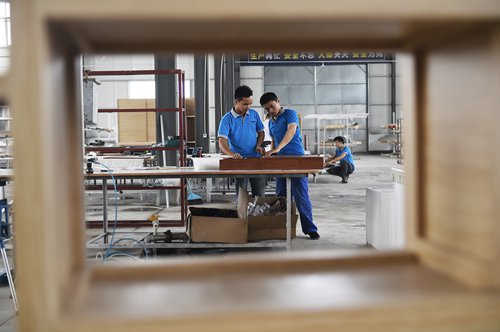
Workers assemble cupboards at a factory in Zouping county, East China's Shandong Province. (Photo: IC)
With China's furniture industry falling into uncharted waters every day, the recent news that the sector's two star companies have filed for bankruptcy has brought it to its knees.
Based in East China's Fujian Province, haolaiwuchugui.com (Haolaiwu) and Chengfeng Furniture Co were experiencing a phase of liquidation bankruptcy as of August 21, according to a report released by pedaily.cn, a portal for investment news.
The trials and tribulations of these two Fujian furniture companies are just a microcosm of the whole of China's furniture industry.
Over the past three years, a dark cloud has been hovering over the domestic furniture industry, as many small- and medium-sized companies have run into troubles.
Falling stars
China's decoration and closet sectors had been experiencing explosive growth since 2003 thanks to rising market demand, the pedaily.cn report said.
Haolaiwu, which was established in 2001, took advantage of this and began expanding in 2010.
Before long, it became representative of Fujian's furniture sector. The company now owns 629 franchised outlets across China and had planned to raise that number to more than 1,000 in the next two to three years, according to its website.
However, there are underlying problems in the sector, mainly in relation to large attraction of investments.
Also, since 2015, many closet firms have been shutting down while Haolaiwu has been facing many lawsuits as the company has failed to pay its employees, the report said.
According to the National Business Daily, over the past five years, Haolaiwu has been involved in 15 financial loan contract disputes, 15 sale contract disputes, five labor disputes and three private lending disputes.
Similar to Haolaiwu, Chengfeng has also been involved in many disputes with banks and employees.
Experts attributed the collapses to factors such as poor business operations and the sluggish furniture industry environment.
A boss' confession
A confession letter written by an executive of a bankrupt furniture company that recently went viral has resonated with many furniture business owners, according to the pedaily.cn report.
"I started my furniture business in 2008," the report said, citing the executive who does not reveal their identity.
"Solid wood sofas produced by many regular furniture firms are made of imported hardwood, but in a bid to reduce costs and promote sales, I bought cedarwood to make my solid wood sofas," they wrote.
"Regular plants use solid wood to make sofa feet, but I used plaster to increase its weight, with the aim of earning the most profits but with the lowest possible costs," they continued, adding that such conduct exploited legal loopholes but that they had to do so "in order to survive", a confession showing the struggles of some Chinese furniture stores in the early development stage.
"The turning point came in 2014… when I expanded the production scale and increased the amount of equipment and employees - I got prepared for hard work."
But that same year, growth in the sector at large slowed, as sales fell across the country, the executive said, noting that "my capital chain became short when sales continued to drop throughout 2015 so I had no choice but to shut down my plant."
Before the collapse of their business, the executive witnessed the collapse of three other furniture factories in the local area.
"Now I understand, as people's living standards continue to improve, it is not that there is a lack of demand in the market, it is that the Chinese retail market has already embarked on the trend of consumption of high-quality goods," they wrote.
"As long as the brand does not have core competitive products, it will be shuffled out of the furniture market or even the retail market sooner or later."
Need to upgrade
From the perspective of the outside world, since the Chinese furniture industry has borne its own "bitter fruit", it seems reasonable to eliminate such a traditional sector that causes high pollution and with high-energy consumption, said the pedaily.cn report.
On January 1, the Chinese government introduced a new tax policy - the environment protection tax - in an aim to protect the environment and prevent the emission of pollutants.
So far, nearly 30 provinces, municipalities and autonomous regions have announced how much they will tax and how many environment-related projects they will run.
The charging standard of Beijing is the highest in the country, while the environmental tax standards in provinces and municipalities like East China's Jiangsu Province, North China's Tianjin Municipality, North China's Hebei Province and Southwest China's Sichuan Province are three to five times the minimum standard.
A medium-sized furniture enterprise, for instance, will therefore pay around 300,000 yuan ($44,050) to 700,000 yuan in environmental protection tax every year, a huge burden for companies with low profits, according to the pedaily.cn report.
In a bid to invigorate the sector by improving production and enhancing sales and service patterns, furniture companies are expected to seek transformation and upgrading through making good use of internet, big data and modern technology, according to industry experts.
Meanwhile, with the rollout of environmental protection policies and industrial regulations, furniture companies are expected to shift from taking on the role of producers to being life service providers while gradually upgrading from the low-end to the middle- and high-end of the value chain, the experts said.


